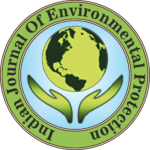IJEP 41(5): 575-583 : Vol. 41 Issue. 5 (May 2021)
A. Shwetha1, M.C. Sampath Kumar2* and M. Rajyalakshmi2
1. Presidency University, Department of Civil Engineering, Bengaluru – 560 064, Karnataka, India
2. BMS College of Engineering, Department of Civil Engineering, Bengaluru – 560 019, Karnataka, India
Abstract
The main objective of this study was to assess aquifer vulnerability usinga modified DRASTIC model (DRASTICA) to develop vulnerability mapping in Hoskote taluk, Bengaluru. Here, ERDAS IMAGINE software and ArcGIS software are used. The DRASTIC parameters, such as depth of water level (D), recharge (R), aquifer media (A), soil media (S), topography (T), impact of vadose zone (I), hydraulic conductivity (C) were all referred. In ‘DRASTICA’ ‘A’ refers to a new parameter called impact of anthropogenic activities (A) to access the human impact on the groundwater resources in the study area. Step by step basic data was collected, that is satellite data, population density, water level, recharge, borehole data, soil data and digital elevation model (DEM). The original ‘DRASTIC’ model was altered by including anthropogenic impact (A) using analytical hierarchy process (AHP) which is used for determining the ratings of each parameter in the modified-DRASTIC method and was processed in GIS to generate groundwater vulnerable zones. As GIS enables the visual interpretation of data, this has given specific maps for specific analysis and as a result, 80% of the study lies under very high vulnerable zone while in other areas, the potential for pollution is comparatively less. Spatial analysis indicated that anthropogenic impact influenced pollution, thereby human activities has to be addressed. It was observed that the modified ‘DRASTICA’ model is more suitable and precise for the present study.
Keywords
Groundwater vulnerability, DRASTICA model, ARC GIS, Hoskote taluk
References
- Vasanthavigar, M., et al. 2010. Application of water quality index for groundwater quality assessment : Thirumanimuttar sub-basin, Tamil Nadu. Env. Monit. Assess., 171:595-609.
- Kumar, D. and S. Ahmed. 2003. Seasonal behaviour of spactial variability of groundwater level in a granitic aquifer in monsoon climate. Current Sci., 188-196.
- Smith, Keith. 2013. Environmental hazards : Assessing risk and reducing disaster. Routledge.
- Frankowski, M., et al. 2009. Distribution of heavy metals in the Malawelna river system (Western Poland). Oceanol. Hydrobiol. Studies. 38:51-61.
- Kozlowski, M. and J. Komisarek. 2013. Temporal variability of selected dissolved components content in groundwater of the catena system of Poznan’ lakeland. Rocznik Ochrona Srodowiska. 15:1965-1981.
- Kozlowski, M. and J. komisarek. 2017. Groundwater chemistry and hydrogeochemical processes in a soil catena of the Poznan’ lakeland, Central Poland. J. Elementol., 22:681-695.
- Siepak, M. and M. Sojka. 2017. Application of multivariate statistical approach to identify trace elements sources in surface water : A case study of Kowalskie and Stare Miasto reservoirs, Poland. Env. Monit. Assess., 189:364.
- Vrba, J. and A. Zaporozec. 1994. Guidebook on mapping groundwater vulnerability. International contributions to hydrogeology (ver. 16).
- Ahmed, I., et al. 2015. Hydrogeological vulnerability and pollution risk mapping of the Saq and overlying aquifers using the DRASTIC model and GIS techniques, NW Saudi Arabia. Env. Earth Sci., 74:1303-1318.
- Aller, L., et al. 1987. DRASTIC : A standardized system for evaluating groundwater pollution potential using hydrogeologic settings. U.S. Environmental Protection Agency, Washington, D.C. pp 455.
- Evans, B. M. and W. L. Myers. 1990. A GIS-based approach to evaluating regional groundwater pollution potential with DRASTIC. J. Soil Water Conser., 45:242-245.
- Rosen, Lars. 1994. A study of the DRASTIC methodology with emhasis on Swedish conditions. Groundwater. 32:278-285.
- Rahman, Atiqur. 2008. A GIS based DRASTIC model for assessing groundwater vulnerability in shallow aquifer in Aligarh. Appl. Geography. 28:32-53.
- Leone, A., et al. 2009. Vulnerability and risk evaluation of agricultural nitrogen pollution for Hungary’s main aquifer using DRASTIC and GLEAMS models. J. Env. Manage., 90:2969-2978.
- Anane, M., et al. 2013. GIS-based DRASTIC, pesticide DRASTIC susceptibility index (SI): Comparative study for evaluation of pollution potential in the Nabeul-Hanmamet shallow aquifer, Tunisia. Hydrogeol. J., 21:715-731.
- Shrestha, S., D. J. Semkuyu and P. Pandey. 2016. Assessment of groundwater vulnerability and risk to pollution in Kathmandu valley, Nepal. Sci. Total Env., 556:23-35.
- Sinan, M. and M. Razack. 2009. An extension to the DRASTIC model to assess groundwater vulnerability to pollution : Application to the Haouz aquifer of Marrkech (Morocco). Env. Geol., 57:349-363.
- Sener, E., S. Sener and A. Davraz. 2009. Assessment of aquifer vulnerability based on GIS and DRASTIC methods : A case study of the Senirkent-Uluborlu basin (Isparta, Turkey). Hydrogeol. J., 17. DOI : 10.1007/S10040-009-0497-0.
- Sener, E. and A. Davraz. 2013. Assessment of groundwater vulnerability based on a modified DRASTIC model, GIS and an analytical hierarchy process (AHP) method : The case of Egirdir lake basin (Isparta, Turkey). Hydrogeol. J., 21:701-714.
- Batelaan, O. and F. De Smedt. 2007. GIS-based recharge estimation by coupling surface-subsurface water balances. J. Hydrol., 337:337-355.
- Umar, R. and F. Alam. 2012. Assessment of hydrogeochemical characteristics of groundwater in parts of Hindon-Yamuna interfluve region, Baghpat district, western Uttar Pradesh. Env. Monit. Assess., 184:232-236.
- Umar, R., I. Ahmed and F. Alam. 2009. Mapping groundwater vulnerable zones using modified DRASTIC approach of an alluvial aquifer in parts of central Ganga plain, western Uttar Pradesh. J. Geol. Society India. 73:193-201.
- Al Hallaq, A. H. and B. S. Abu Elaish. 2012. Assessment of aquifer vulnerability to contamination in Khanyounis Governorate, Gaza strip, Palestine, using the DRASTIC model-within GIS environment. Arabian J. Geosci., 5:833-847.
- Shirazi, S.M., et al. 2013. Groundwater vulnerability assessment in the Melaka state of Malaysia using DRASTIC and GIS techniques. Env. Earth Sci., 70:2293-2304.
- Rao, D., et al. 2018. Assessment of vulnerability zones for groundwater pollution using GIS-DRASTIC-EC model : A field-based approach. J. Earth System Sci., 127:49.
- Klug, Jerrod. 2009. Modeling the risk of groundwater contamination using DRASTIC and geographic information systems in Houston Country Minnesota. Papers in Resources analysis-II. Saint Mary’s University of Minnesota. University Central Services Press, Winona.
